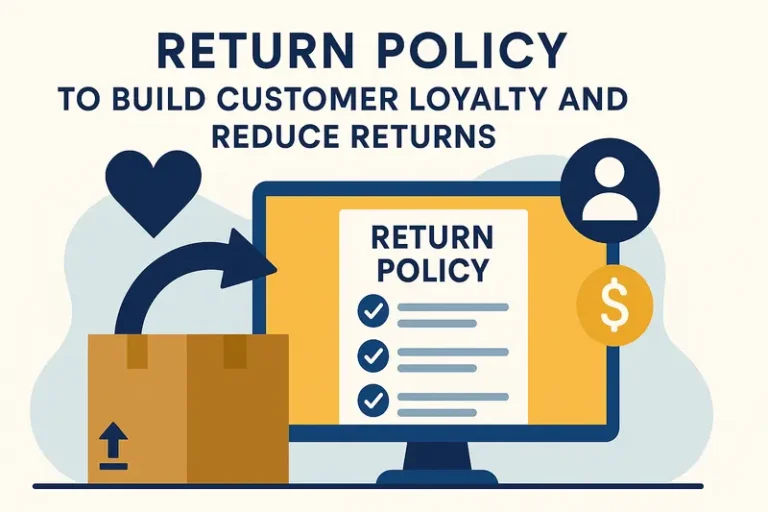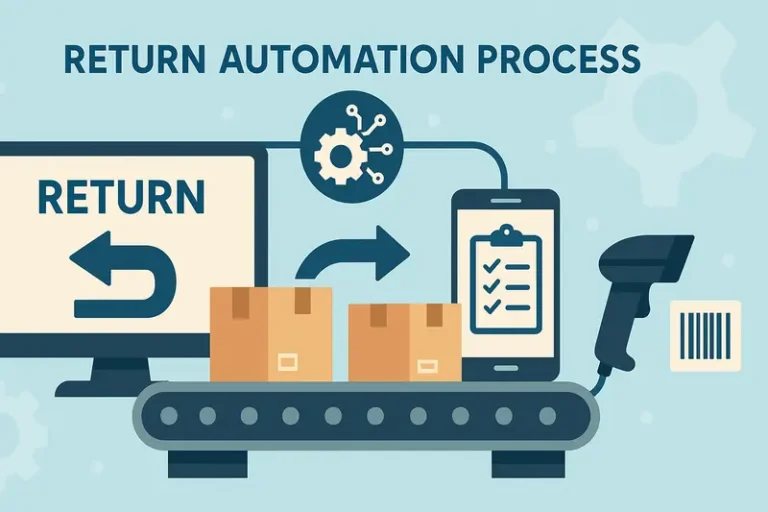How Ecommerce Returns Management Software Boosts Efficiency and Customer Loyalty

Last updated on April 29, 2025

In this article
 9 minutes
9 minutes
- Why Returns Management Can’t Be an Afterthought
- What Returns Management Software Actually Does
- The ROI of Returns Management Solutions
- Why Reverse Logistics Matters
- Strategies for Reducing Returns
- Choosing the Right Returns Management Software
- Measuring Success: KPIs and Analytics for Returns Management
- My Perspective After a Decade in the Trenches
- The Future of Returns Management in Ecommerce
- Frequently Asked Questions
Returns used to be the messy backroom of ecommerce, hidden, clunky, and full of manual work. Not anymore. Commerce returns have emerged as both a major challenge and a significant opportunity for online retailers. In 2025, ecommerce returns management has become a strategic lever for customer loyalty, profit recovery, and operational speed. The importance of ecommerce returns management now extends beyond logistics, shaping competitive advantage and customer satisfaction in the digital age. After many years working with ecommerce brands and managing a distributed warehouse network, I’ve seen how the right returns management platform transforms what’s usually a pain point into a growth engine for both you and your customers.
Why Returns Management Can’t Be an Afterthought
Returns aren’t just a post-purchase nuisance. They are a customer experience touchpoint that directly affects customer lifetime value. The National Retail Federation reports that returns accounted for more than 17% of total retail sales in 2024. Return rates are even higher for online purchases compared to physical store sales, making a seamless returns process critical for ecommerce success. Every poor return experience risks losing customers, negative feedback, and lower repeat business.
I’ve seen merchants attempt to manage returns through spreadsheets and email threads, but it’s not scalable. The lack of a structured returns process and a clear returns policy leads to lost sales, inventory mismatches, refund delays, and angry customers by creating confusion and unmet expectations. Without the right returns management software, your customer service team spends hours just sending return labels and processing refunds manually.
Make Returns Profitable, Yes!
Cut shipping and processing costs by 70% with our patented peer-to-peer returns solution. 4x faster than traditional returns.
See How It WorksWhat Returns Management Software Actually Does
Good returns management software offers far more than a shipping label creation tool. It’s a comprehensive, all-in-one platform that automates and streamlines the entire process, from return authorization to inventory management and refund reporting. Key features typically include:
- Automated returns authorization to speed up approvals and reduce manual intervention.
- A customizable returns portal where customers can initiate and track their returns and exchanges.
- Self-service return portals that let online shoppers initiate returns without emailing support.
- Dynamic return rules for exchanges, store credit, or refunds, helping to protect profit margins.
- Streamlined returns processing to reduce support tickets and speed up the entire process.
- Real-time returns tracking functionality to keep both merchants and customers updated on return status.
- Automated exchange process options to encourage customers to swap products rather than request refunds.
- Automatic refunds processing capabilities to ensure timely and accurate refunds.
- Initiating refunds automatically once returns are approved, reducing manual errors.
- Real-time tracking of returns data, giving you insight into why products are being sent back.
- Integration with warehouse management systems ensures that inventory updates are instantly applied upon receipt.
- Fraud detection to combat return fraud and identify stolen merchandise patterns.
Merchants using returns management software often see customer satisfaction rise because the process is quick, transparent, and easy to navigate.
The ROI of Returns Management Solutions
A well-optimized returns management process offers key benefits that go beyond cost savings, including improved customer satisfaction, increased operational efficiency, and more revenue for your business.
Returns may feel like a cost center, but a well-optimized returns management process can actually increase revenue. How? By:
- Boosting customer loyalty with frictionless refunds and exchanges.
- Reducing reverse logistics expenses through automated label creation and bulk carrier discounts.
- Using returns data to improve product descriptions and reduce future returns.
- Recovering sales via store credit or streamlined exchange processes instead of one-click refunds.
- Retaining more revenue by minimizing unnecessary returns through efficient returns management.
From my experience, ecommerce businesses that prioritize customer satisfaction during the returns stage—by streamlining the process and offering easy-to-use return labels—see higher repeat business and better reviews. That translates to stronger brand loyalty, a healthier bottom line, and helps retain future customers.
Why Reverse Logistics Matters
The reverse logistics process—moving items from customers back to warehouses or physical stores—is more complex than most merchants realize. Without software, this process eats into profit margins and clogs warehouse management systems.
Modern returns management platforms integrate directly with inventory management tools, ensuring returned products are inspected, restocked, or flagged for disposal quickly. These integrations help maintain accurate inventory levels by seamlessly updating stock data during the returns process, preventing overselling or shortages. This saves time and prevents inventory from sitting idle, which otherwise delays future sales.
Offering unlimited returns—while once a popular strategy to attract customers—can create significant operational challenges for reverse logistics and inventory management due to increased processing costs and complexity.
Convert Returns Into New Sales and Profits
Our peer-to-peer returns system instantly resells returned items—no warehouse processing, and get paid before you refund.
I'm Interested in Peer-to-Peer ReturnsStrategies for Reducing Returns
Reducing returns is not just about protecting your bottom line; it’s about building trust and loyalty with your customers. For ecommerce businesses, a proactive approach to minimizing returns can significantly enhance customer satisfaction and streamline the returns process. One of the most effective strategies is to provide customers with comprehensive, accurate product information. High-quality images, detailed specifications, and authentic customer reviews help set clear expectations, reducing the chances of disappointment and unnecessary returns.
Another powerful tactic is to offer pre-sale consultations, such as live chat or virtual shopping assistance, to guide customers toward the right purchase. Post-sale follow-ups, like satisfaction surveys or helpful tips for product use, can address potential issues before they lead to a return. By making the returns process itself more transparent and user-friendly—through features like a self-service return portal and clear return policies—ecommerce businesses can further boost customer loyalty and reduce the volume of returns.
Ultimately, these strategies not only decrease return rates but also enhance customer satisfaction, turning first-time buyers into repeat customers and advocates for your brand.
Choosing the Right Returns Management Software
When evaluating a returns management solution for your online store, look for:
- Scalable features that match both current needs and future returns volume.
- Multi-channel support for both online returns and store returns.
- Customer communication tools to keep customers informed of their return status.
- Reporting capabilities for refund reports, product performance, and fraud analytics.
- Easy integration with your ecommerce platform and shipping carriers.
- Consider returns management software that offers free returns and free shipping options to enhance customer experience.
The best tools don’t just manage returns—they improve the customer experience, turning a negative moment into an opportunity to strengthen relationships. The right returns management solution can integrate with your store to streamline returns and exchanges.
Measuring Success: KPIs and Analytics for Returns Management
To truly optimize your returns management process, it’s essential to measure what matters. Ecommerce businesses should track key performance indicators (KPIs) such as return rate, reasons for return, customer satisfaction scores, and net promoter score. By analyzing returns data, you can uncover patterns, like which products are most frequently returned and why, which empowers you to make informed decisions about inventory management, product descriptions, and future product development.
For example, if returns data reveals that a particular item is often sent back due to sizing issues, you can update your sizing guides or add more detailed fit information to reduce future returns. Monitoring customer satisfaction throughout the returns process also helps identify pain points and opportunities to enhance the customer experience. Leveraging these analytics not only improves your returns management but also supports smarter business decisions, leading to higher customer satisfaction and increased revenue for your ecommerce business.
My Perspective After a Decade in the Trenches
I’ve seen brands waste thousands of dollars and countless hours on manual returns. Conversely, I’ve seen what happens when they adopt modern returns management software: faster processing, happier customers, and better informed decisions about product quality and operations.
Returns are often dismissed as unavoidable losses, but they’re actually a lens into your customer expectations, product quality, and operational gaps. Brands that treat returns as part of their customer experience strategy, rather than as an afterthought, see measurable lifts in customer lifetime value. Collecting and analyzing customer feedback is essential for continuously improving the returns process and ensuring it meets customer needs.
Even small changes, like offering free return shipping with a clear return policy, can dramatically improve repeat business. And when you combine those practices with a modern returns management platform, you’re not just reducing costs—you’re building long-term trust. Providing accurate product descriptions also helps reduce returns and strengthens customer trust.
No More Return Waste
Help the planet and your profits—our award-winning returns tech reduces landfill waste and recycles value. Real savings, No greenwashing!
Learn About Sustainable ReturnsThe Future of Returns Management in Ecommerce
Looking ahead, the future of returns management in ecommerce is all about delivering a seamless, customer-focused experience that drives both customer satisfaction and loyalty. As online shopping continues to expand, ecommerce businesses must prioritize efficient, transparent, and flexible returns processes to stay competitive. By investing in accurate product information, simplifying the returns process, and harnessing the power of returns data analytics, businesses can reduce return rates, improve operational efficiency, and foster long-term customer relationships.
Returns management software will play a pivotal role in automating and optimizing these processes, helping ecommerce businesses save time, reduce costs, and make data-driven decisions. Those who embrace a proactive, customer-centric approach to returns management will not only meet but exceed customer expectations, turning returns from a challenge into a strategic advantage. In the evolving world of ecommerce, prioritizing returns management is key to building customer loyalty, enhancing customer satisfaction, and driving sustainable business growth.
Returns are going to keep rising. The question is whether you’ll treat them as a competitive advantage or let them chip away at your business.
Frequently Asked Questions
What is ecommerce returns management software?
It’s a comprehensive returns management solution designed to automate and streamline the returns process, from issuing return labels to tracking returned inventory and processing refunds or exchanges.
How does ecommerce returns management software boost customer satisfaction?
By providing a clear, fast, and self-service returns experience, customers feel informed and cared for. This improves overall trust and encourages repeat purchases.
Can ecommerce returns management platforms reduce costs?
Yes. Automation reduces labor hours, prevents errors, and cuts carrier costs by using bulk return labels and smarter reverse logistics routing.
Why is reverse logistics important?
Reverse logistics affects inventory turnover, customer wait times, and overall efficiency. Software ensures products move smoothly back into inventory or secondary channels.
Does Cahoot offer returns management capabilities?
Yes. Cahoot’s returns management tools integrate with ecommerce platforms and warehouse management systems, providing fast processing, cost savings, and actionable returns data.

Turn Returns Into New Revenue





